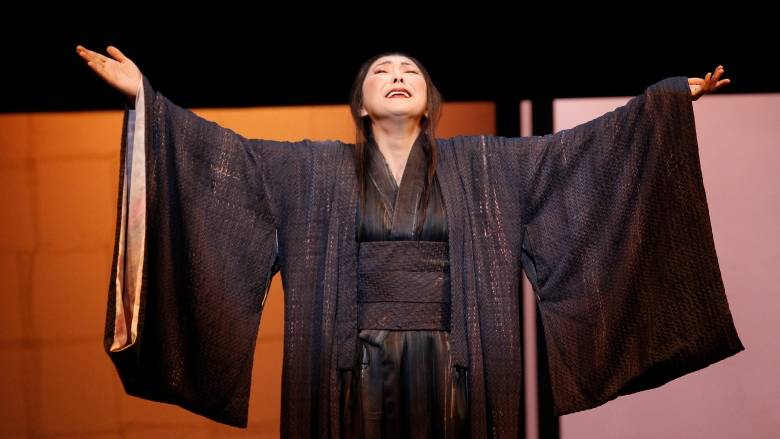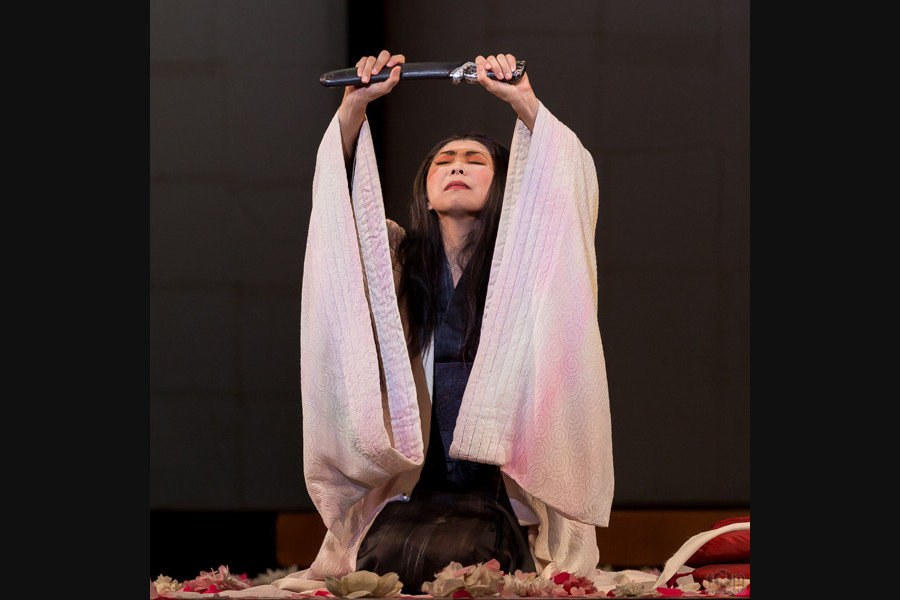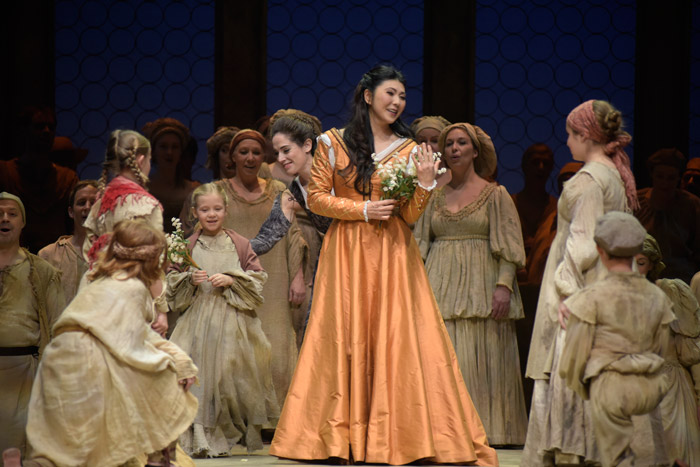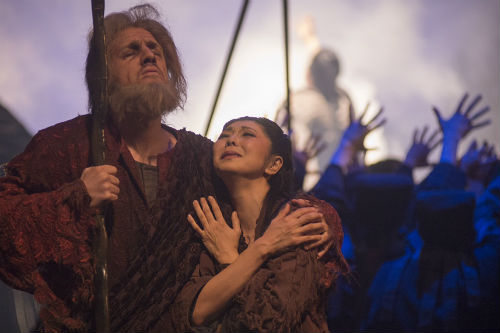|
| |
| |
BIOGRAPHY |
|
|
‚Hiromi Omura started the 2017-18 season with her return to the Latvian National Opera in her signature role MADAMA BUTTERFLY under the baton of Alberto Veronesi. This very role she also sings at the Tokyo Bunka Kaikan with the Tokyo Symphony Orchestra and in Saga (South of Japan) with the Tokyo City Philharmonic Orchestra conducted by Gaetano D'Espinosa. She portrays CIO-CIO-SAN at the Manitoba Opera in Canada and in an new production at the Finnish National Opera Helsinki. In summer 2018 she makes her debut in this very role at the Puccini Festival Torre del Lago in Italy.
Since 2004 Hiromi Omura sings the title role in “Madama Butterfly”. Throughout the world her portrayals of this very role are frenetically acclaimed by critics and audience alike. She enjoyed already great successes as CIO-CIO-SAN at the New National Theatre Tokyo, the German Opera Berlin, the Montreal Opera House, in Malaga, Cordoba, Metz, at the Lausanne Opera, the Polish National Opera (Wielki Theatre), the Savolinna Opera Festival in Finland... With the Opera Australia she performed in a new production of Ales Ollé (La Fura dels Baus) for the Handa Opera on Sydney Harbour. The DVD of this production has been released from ABC Classics.
The artist sang in the New Year Opera Concert 2018 at the by NHK Hall. This concert was broadcasted live at NHK TV. She also performed in a New Year Gala Concert at Suntory Hall with the Tokyo Symphony Orchestra.
Recently, the soprano enjoyed great success as NORMA at the Bunkamura Orchard Hall (Tokyo) with the Tokyo Philharmonic City Orchestra under the musical direction of Riccardo Frizza.
Other highlights include a.o. her first TOSCA with the Tokyo Metropolitan Symphony Orchestra under the baton of Maestro Daniele Rustioni at the Tokyo Bunka Kaikan, DESDEMONA in “Otello” under the musical direction of Keri-Lynn Wilson in a Glynis Leyshon production. She appeared as the COMTESSA d’Almaviva in Mozart’s “Le nozze di Figaro” at the Tokyo Bunka Kaikan at the Nikikai Opera under Sascha Goetzel’s musical direction.
In 2014-15 Himori Omura made her debut in South America at the Theatro Municipal Rio, returned to the Sydney Opera House and the Melbourne State Theatre for their season opening as CIO-CIO-SAN.
Other guest appearances include NORMA (Norma/Bellini) at the Lausanne Opera and the Toulon Opera , DESDEMONA (Otello) at the Toulon Opera and the Opera National de Lorraine, where she has also performed SILVIA (Zanetto/Mascagni) and the CONTESSA (Le nozze di Figaro/Mozart), LIU (Turandot/ Puccini), AMELIA (Simon Boccanegra/ Verdi) and LEONORA (Il Trovatore/ Verdi) at the Montreal Opera.
The Japanese soprano, who lives in France, made her Master of Arts in singing at the Tokyo National University of Fine Arts and Music. She completed her musical studies in Matua and Milano.
Hiromi Omura was the 1st prize winner in the Concours International d’Opéra de Marseille (2001), and won prizes in international competitions such as the Concours International de chant de Paris(Paris), the Belvedere Competition (Vienna), the Concorso Ismaele Voltolini (Buscoldo,Mantua/ Italy), the Concorso Gianfranco Masini (Reggio Emilia/ Italy) among others.
After first appearances as VIOLETTA (La Traviata/ Verdi) at the Nikikai Opera House in her native country Japan, she made her debut at the New National Theatre Tokyo in 2004 in the role of MICAELA (Carmen/Bizet). Subsequently she returned to this theatre in such roles as CIO-CIO-SAN, NEDDA (I Pagliacci) and ELISABETTA (Don Carlo).
Hiromi Omura is also a very much sought-after concert singer. She sang the Deutsches Requiem (Brahms) at the City of London Festival with the London Symphony Orchestra conducted by Tadaaki Otaka. With the Tokyo Philharmonic Orchestra she performed Beethoven’s 9th Symphony, the Miss Solemnis and Mozart’s Mass in C minor. She sang Beethoven’s 9th with the Nancy Symphony Orchestra, Händel’s Messias with the Orchestre de Picardie and “ A Midsummer Night’s Dream” and “Elias" (Mendelssohn) with the French National Orchestra under Kurt Mazur.
|
|
|
| |
| |
| REVIEWS |
| |
| Manitoba Opera – MADAMA BUTTERFLY |
| …a particularly strong cast of principals in the opera’s notoriously difficult roles. The first of those is world-renowned Tokyo-born soprano Hiromi Omura, performing the role for her 101st time while also marking her MO debut; she delivers a masterful portrayal of the young geisha. She morphs before our eyes from lovesick girl to noble young woman who chooses to die for honour, her soaring, well-paced vocals displayed from her opening Ancora un passo or via — Spira sul mar, until her final, heart-stopping "suicide aria," Con onor muore. |
| Winnipeg Free Press – Holly Harris – Nov. 2017 |
| Madama Butterfly, also known as Cio-Cio-San, was portrayed with great emotion and depth by Japanese soprano Hiromi Omura. Her entrance really moved me, when she was climbing the hill with her geisha girlfriends to get to Pinkerton's rented house on the shores of Lake Nagasaki. |
| Schmopera – Neil Weisenel – Nov. 2017 |
| Opéra de Montreal – Otello - DESDEMONA |
| As Desdemona, Japanese soprano Hiromi Omura also pleased as both singer and actor. The epitome of the sweet, loving bride who becomes stricken by grief and fear, she sang with extraordinary expression and emotional intensity. In the dramatic Willow Song in particular, her voice soared powerfully from pianissimo and mezzo-lows, to top notes of exquisite purity. |
| Backtrack – Patricia Maunder – 2016 |
| ...but above all Hiromi Omura (Desdemona). With a voice that is strong and clystal-clear at the same time, this young Japanese soprano perfectly portrays the character. |
| Notre Montréalité – Frank |
| Melbourne State Theatre – MADAMA BUTTERFLY |
| Moffat Oxenbould's cherished production of Madama Butterfly goes out in high style with sublime soprano Hiromi Omura giving an exquisitely calibrated tour de force performance.Emanating a vibe that is the antithesis of the stereotypical opera diva, Omura simultaneously commands attention whilst also maintaining a demure and serene grace. Omura's silken soprano pours forth in shimmering waves, conveying the spectrum of Butterfly's modesty, anticipation, joy, fear and heartbreak. Such is Omura's tireless stamina, at evening's end she seems like she would be able to start at the beginning and sing it all over again. Enhancing Omura's rich vocal colour is her highly expressive countenance. The suspension of disbelief required to see Omura as a teenager is simple given the way she beams first with innocent radiance and then with the ecstasy of first love. Omura is particularly convincing in portraying Butterfly’s resolute mania as the deluded young woman steadfastly awaits the return of her American "husband." Finally, the beaming face crumbles to ashen despair as the realization sinks in that Pinkerton is not returning to her. |
| …Man in a Chair – Simon Parris |
| Hiromi Omura's elegant and affecting Cio-Cio-San dominated the night, as she should have. Not only did she possess the right vocal sensitivity and power, her Butterfly was no shrinking violet (so to speak); rather, there was zealousness in Omura's character, an almost neurotic edge that made her the object of fascination as well as sympathy. Overall, Omura gave a telling performance that treated Puccini's great heroine with honour. |
| Sydney Morning Herald – Michael Smith |
| In a strikingly informative performance, soprano Hiromi Omura imbued Butterfly with a laudable ambiguity, battling pity and personal expectations embodied in Japanese “honne-tatemae” characteristics — the contrast between true inner feelings and outward behaviour.
Butterfly's teenage transition was breathtakingly portrayed by Omura' poignantly phrased, elegant soprano, feathery pianissimo and an attractively light vibrato to capture the determination of the coy 15-year-old, the delusional 18 year-old, and the grief of finally losing everything. |
| Herald Sun – Paul Selar |
| She is a true singing actress: each performance brings fresh nuances and feels inhabited, not studied. Her endless fussing and fluttering during the scene with Sharpless reminded us of a saké-fied Mary Tyrone or Blanche DuBois. In the final scene, Cio-Cio-San struggled with the prostrated Suzuki on seeing Kate Pinkerton, only to hiss at her (Vespa! voglio / Che tu risponda). At the end, fate sealed, deed done, a half-smile of something like triumph played over her face as she heard Pinkerton terrifiedly climbing that fateful collina. ...
At the end of the opera, one half of the stalls (the eastern side, as it happened) was immediately on its feet, while the other half stayed comfortably seated; but after the curtain calls nearly everyone stood up to acknowledge this remarkable performance. Omura is a commanding performer; her Cio-Cio-San sets the standard against which all Australian Butterflys will surely be measured for years to come. |
| Australian Book Review – Peter Rose |
| Opéra de Montréal – Turandot – LIU |
| All singers projected exceptionally well to the rear of the parterre, a relative rarity in the immense 3000-seat Salle Wilfrid-Pelletier. The standout was Japanese soprano Hiromi Omura as Liù. Her high notes in Act One’s "Signore, ascolta" rang with crystal clarity, and her final aria in Act Three, "Tu che di gel sei cinta" had warmth and pathos aplenty to melt the most hardened heart. |
| Concerto.Net – Earl Arthure |
| Handa Opera on Syney Harbour – Opera Australia – MADAMA BUTTERFLY |
| Japanese soprano Hiromi Omura ... is sensational as Butterfly, her glorious, shining voice matched by wonderfully expressive acting. |
| The Telegraph – Jo Litson Arts Writer |
| In a towering achievement, Japanese soprano Hiromi Omura gives an outstanding performance in the title role, matching the extraordinary splendour of her voice with the strength of her acting. For much of act two, the entire set and seating bank are absolutely bathed in the lush beauty of Omura’s all-powerful voice. As the story progresses, Butterfly becomes increasingly manic, and Omura immerses her every fibre in this mania, successfully and affectingly transmitting Butterfly’s desperate blind optimism right to the back rows of the bleachers. Omura breaks our hearts for Butterfly tragic plight, and received a full standing ovation, specifically for her, on opening night. |
| Theatre People – Simon Parris |
| Hiromi Omura sings Cio-Cio-San with peerless bony strength and smoothness and a focused sound that cuts thrillingly through the night air (and would do more so if the amplification followed her lead instead of airbrushing and boosting). |
| Sydney Morning Herald – Peter McCallum |
| Opéra de Toulon – NORMA |
| The soprano Hiromi Omura emerged with honour from the difficult role of Norma, whose performance history, as we know, has always been the realm of major singers and considered, frankly, arduous. Ms Omura displayed great musicality, and right from the terrifying Casta Diva was securely in charge of the role, thanks to her excellent vocal colour and technical precision in the coloratura passages. Ms Omura also succeeded in injecting the right tone of pathos and drama at the key moments of the opera: the duets with Adalgisa and the finales of each act.
|
| GB OPERA / Jocelyne De Nicola |
| The Japanese soprano Hiromi Omura, a convincing Desdemona last season, is a Norma of great integrity, perfectly mastering the belcanto style. Her Norma is precise. She offers us a remarkable sense of legato and a mastery of pianissimo that has become rare. Excellent technician, she is able to transmit the interior emotions the character undergoes, and succeeds therefore in moving us. She is without doubt the revelation of this performance!
|
| PerformArts / Serge Alexandre |
| The ecstatic parenthesis of the invocation to the moon « Casta diva » in no way gives in to slackness or rhythmic languor, but equally does not disturb the lacy delicacy of Hiromi Omura’s vocal line, which gives back to this aria rendered so trite by adverts all its pure, magic charm, begging for the universal peace longer for by women, mothers and lovers. This tenderness, expressed by Omura’s milk and honey voice, only makes more cruel her ultimate desire for a woman’s vengeance against dynastic pride, the implacable male law of descent: to kill her children, to which she cannot resign herself, despite the constant war against betrayed love, hardness against tenderness.
More at ease at priestess than as passionate woman, the Japanese soprano (one thinks of the future sacrifice of Butterfly against the ingratitude of men) serves the formidable vocal line with a faultless technique and shimmering pianissimi.
|
| CLASSIQUENEWS.COM / Benito Pelegrin
|
| |
|
|
| |
| |
| ON STAGE |
 |
| Opera Australia – MADAMA BUTTERFLY |
| |
 |
| Opera Australia – MADAMA BUTTERFLY |
| |
 |
| Opéra de Montréal – Otello – DESDEMONA |
| |
 |
| Opéra de Montréal – Turandot – LIU |
| |
| |
|
|
| |
|